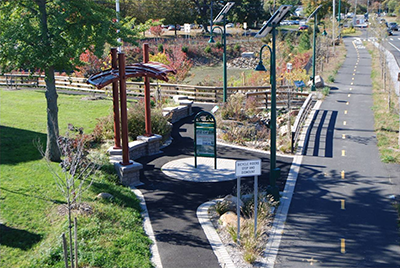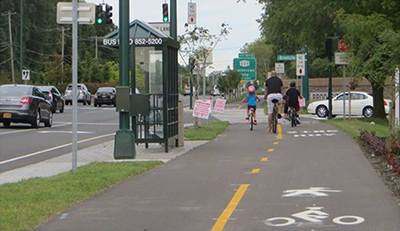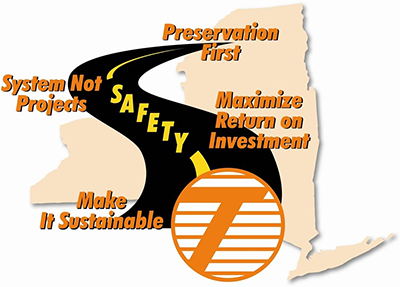
New York State Asset Management Framework
Encourages Preservation and Sustainability
State Departments of Transportation (DOTs) often turn to spot repairs of critical roadway structures without taking the entire transportation system into account. This piecemeal approach restores a specific roadway section in the near term but seldom addresses the long-term reliability of transportation infrastructure.

A focus on sustainability and collaborating with transportation users led NYSDOTto add new transportation features during a reconstruction of Route 347, including a greenway stop, rain garden, information kiosk, and recharge basin. (Courtesy of NYSDOT)
Directed by the New York State Department of Transportation (NYSDOT) Commissioner in May 2011 to incorporate long-term asset management and sustainability into transportation investment decisions, NYSDOT reexamined its capital planning and programming process. Reviews of asset management best practices used by other States guided NYSDOT to develop a preservation first investment strategy. The new emphasis on preservation led the agency to create the Asset Management Framework, an organization-wide structure and process to help all levels of NYSDOT incorporate sustainability into every investment decision. The State’s Asset Management Framework serves as a model for other State DOTs trying to meet the sustainability triple bottom line of economic competitiveness, social equity, and environmental stewardship.
Developing an asset management strategy has helped NYSDOT comply with the Moving Ahead for Progress in the 21st Century Act (MAP-21) requirement for States to develop a risk-based asset management plan. In 2012, NYSDOT received an Exemplary Human Environment Initiatives Award from the Federal Highway Administration (FHWA) for incorporating sustainability into its transportation investment decisions.
Putting Asset Management into Practice
NYSDOT created the Asset Management Framework in order to advance more sustainable programming, generate more consistent decisionmaking, and ensure greater accountability throughout the agency. The framework creates Asset Management Teams at three levels of the organization. These Asset Management Teams are charged with making sure investments support and advance the long-term goals and short-term objectives of the agency, delivering the right project at the right time.
The Executive Capital Program Delivery Committee provides high-level guidance, review, approvals, and decisions related to the overall program and major projects. One level down, the Comprehensive Program Team sets the strategic direction of the Statewide and Regional Asset Management Teams. Finally, Statewide and Regional Asset Management Teams comprised of representatives from planning, design, maintenance, and operations, provide guidance and input to the regional offices as they develop their capital programs.

A family bikes on the newly added shared-use path beside eastbound Route 347. (Courtesy of NYSDOT)
Charged with looking at how to preserve a transportation system that was designed 50 years ago, the Asset Management Teams work to provide NYSDOT’s employees, across all program areas, with the knowledge and tools they need to incorporate sustainability into the agency’s culture and decisionmaking. The broad scope of regional and main office representation on the Statewide Asset Management Teams diversifies asset management understanding, which helps advance projects that serve the entire transportation system. By taking a more holistic view of the network and understanding the role of each asset, NYSDOT can better assess where to spend dollars to service the entire transportation system.
Project decisionmaking and sustainability start at the regional level. In each of New York’s 11 regions, pavement specialists, structural engineers, and safety experts propose infrastructure projects. The projects are reviewed by Asset Management Teams on a regional level and then at a statewide level to make sure the projects conform to New York’s asset management strategy.
For example, the sustainability team may inform the pavement management team that an identified section of highway in need of re-paving is also a critical evacuation route in a known high-risk flood area. Therefore, spending money on a simple preservation would likely be unwise and a resiliency project would be a better investment.

Using a comprehensive preservation first and sustainability approach to asset management led NYSDOT to adopt the Forward Four guiding principles. (Courtesy of NYSDOT)
The Forward Four Preserves Existing Assets
In line with its new emphasis to preserve, maintain, operate, and enhance the safety and condition of its transportation system, the agency also developed the “Forward Four” guiding principles:
The Forward Four guiding principles are woven into every investment decision, providing a safe transportation system for the traveling public. The Asset Management Framework helps the entire agency look at the location and function of a project, and then determine if the project is aligned with the Forward Four principles.
- Preservation First: NYSDOT focuses on preventive, corrective, and demand maintenance using sound asset management principles.
- System Not Projects: NYSDOT looks at where each asset sits within the overall transportation system and who the asset serves.
- Maximize Return on Investment: This approach emphasizes proper management of assets with appropriate treatments, at appropriate times, and at the appropriate locations.
- Make It Sustainable: A sustainable approach to programming considers the relative and cumulative value of transportation assets, incorporating strategies to minimize transportation system disruptions and prioritize enhancements.
These principles ensure that investments are focused on asset management, sustainability, and infrastructure preservation strategies that use sound engineering principles to guide investments for all transportation modes.
Creating a Framework to Preserve Tranportation Assets
Faced with increasing demands on transportation systems and fewer budgetary dollars, State DOTs are looking for ways to better preserve their current systems. NYSDOT’s review of its capital planning and programming process led to a fundamental shift, a reengineering, in the way NYSDOT develops, programs, and funds transportation infrastructure investments. The review led New York to create the Asset Management Framework, an organization-wide structure and process dedicated to preserving the transportation network’s integrity and looking at the future function of the system. Aided by the Forward Four principles, NYSDOT’s Asset Management Framework streamlines the decisionmaking process, enabling engineers, asset managers, and safety experts to be on the same page with executive leadership, so that projects are carried out at the right place at the right time.
Establishing Asset Management Teams at both the statewide and regional level has created the structure needed to advance the NYSDOT’s goal of implementing a strong asset management process. NYSDOT’s Asset Management Framework helps to ensure agency staff at all levels and within all disciplines put preservation first.
Contact Information
Debra Nelson
Strategic Policy Advisor
Operations Division
New York State Department of Transportation
(518) 485-5479
Debra.Nelson@dot.ny.gov
Paul Krekeler
GreenLITESProgram Manager
Policy and Planning Division
New York State Department of Transportation
(518) 457-0919
Paul.Krekeler@dot.ny.gov
Look What’s New!
- FHWA released a new Question and Answer (Q&A) related to Section 1307 of MAP-21. Section 1307 addresses assistance to affected Federal and State agencies. The intent of the new Q&A is to provide guidance on how to implement the provisions of Section 1307 regarding existing and new agreements for a transportation liaison-funded position and how to address projects and priorities in memoranda of understanding. Click here for more information.
- The Steering Committee on Federal Infrastructure Permitting and Review Process Improvement, which includes the U.S. Department of Transportation, published a comprehensive plan to accelerate and expand infrastructure permitting reform government-wide.
- FHWA issued a memo re-emphasizing its responsibility with respect to Tribal Consultation associated with the Federal-Aid Highway Program. For additional information, please review the Tribal Consultation Planning Module on FHWA’s website.
- The Environmental Protection Agency (EPA), as part of its Science to Achieve Results program, recently announced a funding competition seeking applications for Air, Climate, and Energy Centers. EPA is interested in supporting research on the development of sound science to systematically inform policymakers at the State and local levels regarding the development of innovative approaches. Such approaches will enable effective implementation of air pollution control strategies to achieve the greatest public health benefits by reducing exposure to harmful air pollution. Click here for more information.
Successes in Stewardship is a Federal Highway Administration newsletter highlighting current environmental
streamlining and stewardship practices from around the country. Click here to subscribe, or call 617-494-3539 for more information.

